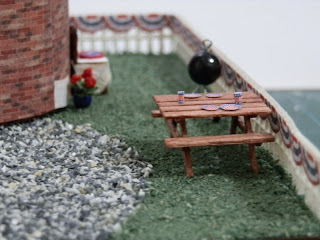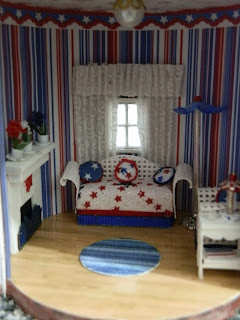Um pouco do contexto histórico da minha futura 'loja de tecidos do final do século 19'. Apesar de todos os fatos históricos aqui apresentados estarem corretos, a interpretação que faço é bem liberal e pessoal. Não tive intenção de ofender ninguém, então "Keep calm e aproveite o passeio histórico!" :)
Now I have to introduce some History background to my future 'end of the 19th century fabric store'. Even though all facts presented here ARE historically correct, the interpretation is... well... mine! :) I don't mean to offend anybody, so just "Keep Calm and enjoy the history tour" ;)
1) Até 1808 o Brasil era só uma coisa: Colônia de Portugal. Aqui não se podia fabricar nada, tudo tinha que ser comprado dos portugueses, que compravam da Inglaterra em troca do ouro, café e açúcar que obtinham daqui. Ao contrário dos EUA, para onde foram pessoas em busca de um novo lugar para criar um novo país e serem livres, aqui para o Brasil foram mandados os piores de Portugal. Condenados pela justiça que vinha trabalhar para diminuir sua sentença, ou pessoas que queriam enriquecer extraíndo as riquezas dos "Quintos dos Infernos" e depois "voltar correndo" para a pátria-mãe e aproveitar a vida por lá. E esta mentalidade permanece no subconsciente de muitos brasileiros até hoje. A ficha ainda não caiu para muita gente que a pátria-mãe é aqui, rsrs...
Ok, pessoas legais vieram também, mas não tinham a menor intenção de começar um novo país livre aqui...
1) Until 1808 Brazil was basically one simple thing: A colony of Portugal. Nothing could be manufactured here, EVERYthing had to be purchased from Portugal, who, on their turn, bought from England and paid with the gold, coffee, sugar, etc, they had obtained from here. Unlike the USA, where freedom-seeking people immigrated from the begging, trying to build a new free-thinking country, the first settlers here were ex-convicts trying to reduce their sentences or greedy businessmen trying to extract as much wealthy "in the boondocks" and then rush back "home" to enjoy their new 'filthy rich' status. This way of thinking is still residual in most Brazilians' subconscious mind... :(
Ok, some nice people did come too, but they never intended to start a "new free-thinking country" here...
 |
| Era assim que o Rio era antes de 1808... This is what Rio de Janeiro looked like before 1808... |
2) So, what happened in 1808 that changed everything? Napoleon's greed for land and power and the well-known rivalry with England pushes Portugal into a corner. Coaxed by England, the whole court: all the royal family, most parliament members, many judges and entrepreneurs - they all fled from Portugal in the middle of the night, gathering their possessions and without planning - they even forgot some treasures on the beach! - and 'moved' the headquarters of the kingdom from Portugal to Brazil. The people of Portugal was left behind to fight for themselves (they did have some help from the English army and navy, but not from their own authorities!). Yes, this was a coward decision and terrible for Portugal. But EXCELLENT for Brazil!!!! Unexpectedly promoted from "the end of the world" to the center of the empire, it was finally allowed to have factories, to make fabrics (until then only a very rustic kind, to be worn by the slaves, was allowed), gun powder, flour, glass, iron, to have schools and universities, hospitals, an army, a bank... all those things any country has and needs, but were not allowed here. For more information on the impact that the arrival of the royal family had on Brazil's destiny, I recommend reading an excellent book: 1808
 |
| A Família Real. Lindos, não? :) The Royal Family. So beautiful!... :) |
 |
| Viagem terrível, que infestou a realeza com piolhos. A terrible 2-months journey, when the royalty got lice. |
There is a very interesting video about the book. It's narrated in Portuguese but you can see more interesting images and places there. If you really want to know more, I can prepare a text with a translation of the video content and send to you, just ask:
Parte 1:
Part 1:
Parte 2:
Part 2:
3) Mesmo com a "abertura dos portos", o Brasil só podia importar da Inglaterra, a única "nação amiga" da época, pois o resto estava em guerra, graças a Napoleão... E a Inglaterra mandava toneladas de coisas que ninguém aqui precisava, como patins de gelo e cobertores de lã (em um país tropical!!!). Mas usando a criatividade, os brasileiros acabavam usando todos os itens como podiam. As lâminas dos tais patins eram usados como facas, por exemplo...
3) But even finally being able to make "international commerce", Brazil could only import from England, the only "friendly nation" back then, as all the rest was under war, thanks to Napoleon... And England sent thousands of useless stuff here, like ice skates and wool blankets (this is a tropical country, geez!!!). Used to making the best from the worst, Brazilians soon found new uses for those items, like using the blades from the skates as knifes, for example...
Vídeo parte 3: Sobre a abertura dos portos
Video, part 3: About the "open commerce between friendly nations"
4) Passados 13 anos, a população portuguesa abandonada que lutou sozinha contra o inimigo, venceu e exigiu a volta de seu rei ou a independência. A Família real não teve outra alternativa a não ser voltar para a terra natal em 1821, deixando aqui seu primogênito D. Pedro I como príncipe regente. Ele, pressionado pela elite que não queria voltar à condição de colônia, declara a independência em 7 de setembro de 1822.
4) 13 years later, the people of Portugal, previously abandoned by the court, had finally defeated the enemy and demanded their king and committee to return, or to become independent. So the Royal Family had no other option than to go back home in 1821, leaving their oldest son here, Prince D. Pedro I as ruler. D. João VI knew that after all the changes he promoted, there was no going back to Brazil as just a simple colony anymore. So he asked his son to take the lead if independence was needed. And that's what happened on September 7th, 1822, when D. Pedro I proclamed the Independency of Brazil.
Vídeo parte 4: Mudanças profundas até a independência
Video, part 4: Deep changes lead to Independency
5) "Declara independência" vírgula! Na verdade "compra" a independência com uma dívida bem cara e uma profunda relação de dependência ainda... Sem contar as dívidas levantadas por conflitos e guerras que ocorreram quando a família real ainda estava por aqui. Como por exemplo, a anexação absurda do Uruguai (província Cisplatina) ao Brasil, por implicância da imperatriz Dª Carlota Joaquina, que quis porque quis. E olha que nem a mesma língua que nós eles falam por lá!...
5) Well... he "proclaimed Independency" is a matter of speaking. As it was all "in the family", he actually PURCHASED our 'Independency', and for a VERY high price... A new huge national debt was created, and even more money was spent in battles all over the country by people who didn't agree on how matters were handled. For example, Uruguay had been "incorporated" by Portugal to Brazil as per the empress Dª Carlota Joaquina wishes, who wanted to reign all over South America. They don't even speak the same language, geez!!! (Spanish, not Portuguese like us)
 |
| Muitas guerras foram travadas no Brasil no séc. 19. Many battles happened in Brazil in the 19th century. |
6) D. João VI dies in Portugal in 1826 and the court demands that D. Pedro I, his heir, returns and becomes their king. No longer popular here, due to his very dictatorial behavior (dissolved the parliament, made the hymn, the flag and the constitution himself, granting himself all-mighty power, of course), he decides to go back to Portugal, and renounces the throne in favor of his 5 year-old son.
 |
| O jovem D. Pedro II The young D. Pedro II |
7) Being so young, of course D. Pedro II couldn't reign, so a system of 'regencies' (or temporary rulers) started. They tried, but didn't do much good, there were many conflicts all over the country. The solution was to change the law and make D. Pedro II officially an 'adult' at the age of 15, in 1831. So he became the emperor of Brazil.
 |
| Um bom e querido regente. A good and loved king. |
8) Being raised from tender age to fulfill his future role, he was a lonely child. But was a fantastic king and brought so much progress to the country! His reign lasted 58 years!!! Thanks to him, very much 'in tune' with the 'state-of-the-art' technology of his time, Brazil was the second country in the world to issue and use stamps (postal system). He also brought the telephone, cars, electricity, among other things. Very much loved by the population, he was demoted by the elite... why? Keep reading...
 |
| segundo selo do mundo! the second stamp in the world is Brazilian! |
9) His daughter, the very intelligent Princess Isabel, signs the "Lei Áurea" on May 13th, 1888, a Bill that finally frees all slaves and ends it completely in the country, after a gradual process that had been happening over the previous decades. But... the landlords did not like that at all. Deprieved from their 'workers', they complain they had not been refunded by their loss. Also, D. Pedro II was very favorable to masonry and didn't care much for the Catholic Church, which had reigned absolute and untouchable until him... Also, the generals in the army wanted to have more saying in the politics. What resulted from that tripod? On November 15th, 1898, D. Pedro II was demoted, exiled and the Republic was announced. Who asked for that again??? The people?... No, not at all! I think that until this day most people still don't really undestand what happened at all...
 |
Princesa Isabel liberta os escravos: o início do fim da monarquia
Princess Isabel frees the slaves: the beginning of the end of monarchy in Brazil
|
10) From then on Brazil was ruled by generals, landlords, businessmen, corrupt politicians, people who only cared for themselves and the money they could take from the people. There was even a name for those times: "Latte"... They alternated the presidents: one was appointed by the farmers who produced milk and the next by the farmers who cultivated coffee... Honestly, I'm not sure politics have really changed in the country, even now!
 |
sim, haviam eleições... mas o povo só podia votar em quem os 'coronéis' mandassem...
yes, there were elections... but the people could only vote on those chosen by the 'landlords'...
|
11) What matters here is that after the slavery was ended, a new kind of labor was needed in Brazil. The former slaves would not accept to work for their previous 'bosses', and white people were horrified by physical labor, as they though it was something perfomed only by "black slaves"... That's when the first settlers from other countries started to arrive. They came in crowded ships, traveling under the worst conditions, being promised a new land and brighter future (pshhh...). They came from many different countries: Italy, France, Spain, Japan, Germany, Netherlands, Arabian countries, etc. They brought with them the disposition to work and the understanding that work is a noble thing that will enable men to grow in life, and also their knowlege and techniques in agriculture, industry and commerce.
 |
mais um navio chega cheio de imigrantes: a nova mão-de-obra
and another ship comes bringing many immigrants: the new labor force
|
E é aí que entra o projeto! :)
And that's when my project starts! :)










































